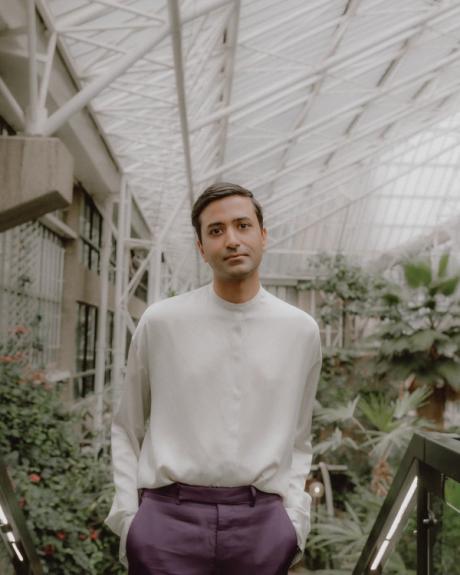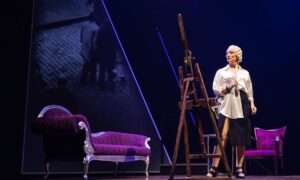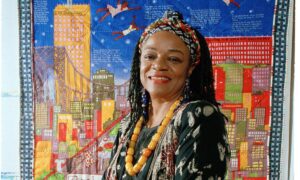
Shanay Jhaveri, the Barbican Centre’s new head of visual arts, is mapping out his future by considering the London institution’s past: “The Barbican’s first administrator, Henry Wrong, described the founding ideals for the programme as ‘modern, exciting and international’,” he says. “I’m keeping that in mind.”In his new role, the Mumbai-born curator oversees exhibitions in both the two-storey Barbican Art Gallery and the smaller ground-floor gallery, The Curve. His first order of business is to “cross the threshold of these spaces” and expand the presence of visual art across the sprawling, Brutalist Barbican Estate, which houses the centre. He wants to “meet the full breadth of the audience which comes to the Barbican, but doesn’t necessarily engage with its visual art programme”.This will be achieved by a new series of site-specific commissions. The first, unveiled on 10 September, sees the south Indian artist Ranjani Shettar handcraft large semi-abstract floral sculptures for the Barbican’s conservatory. They will be suspended from the glass roof, hanging between tropical plants and above koi ponds. It is the first time an artist has ever made work for the conservatory, and only the second time that fine art has been exhibited there (in 2021 a number of Akari lantern sculptures from the centre’s Isamu Noguchi show were displayed in this space).Ranjani Shettar’s work will be installed in the Barbican Conservatory Further plans include the first UK institutional show of Soufiane Ababri in The Curve (13 March-23 June 2024), for which the Moroccan-born, Paris-based artist will show drawings based on his experiences as an Arab gay man living in the West. Ababri is likely to incorporate a performance element within the exhibition, Jhaveri says. Jhaveri’s wider programme also promises a renewed focus on materiality, especially for site-specific commissions. “When I think of the Barbican, I think of concrete—specifically its uniquely textured concrete surfaces that have been hammered by hand to give it this wonderfully haptic quality,” he says. “There has to be a logic underpinning this programme. Shettar’s work, for example, is rigorously process-driven and materially focused, albeit in a different way to the [architectural approach seen at the] Barbican, which makes for interesting dialogue and friction.” Jeffrey Gibson’s SPEAK TO ME SO THAT I CAN UNDERSTAND (2018)© Jeffrey Gibson. Courtesy of Collection Sunderland-Cohen, LondonSuch generative friction is promised in what will be Jhaveri’s first Barbican blockbuster, opening in February next year: a cross-generational group exhibition on textiles featuring some 40 artists including Magdalena Abakanowicz, Tau Lewis and the Women of Gees Bend. Jhaveri says it will build off the legacy of another Barbican group show held last year, Postwar Modern, which helped to rediscover a number of lesser-known postwar British artists, including the painters Jean Cooke and Eva Frankfurther, the latter of who emigrated to England from Germany to avoid persecution under the Nazis. “The model of the postwar show allowed us to revisit certain periods we think we’re familiar with, but through recentering certain figures within those narratives. It combined intellectual rigour with the joy of discovery,” he says. The exhibition, he adds, will travel to the Stedeiljk Museum in Amsterdam in September 2024. A new chapter?The postwar exhibition was one of dozens organised by Jhaveri’s predecessor at the Barbican, Jane Alison. She left the institution in 2022 after 10 years in the post. Not long before Alison’s departure, the institution’s staff base underwent a significant reshuffle following accusations of racist and discriminative behaviour; more than 100 such incidents were published in an online text. A spokesperson for the Barbican says Alison’s departure was not related to these incidents.These accusations prompted the Barbican to commission an independent review of its working structure. Major staffing changes that followed included the creation of senior roles in diversity and workplace safety. “A great deal of work has already gone into building a new culture in which all our people are valued and supported. We have an equity, diversity and inclusion strategy, a clear action plan focused on creating change, and a dedicated team that is supporting the organisation to get us there,” the Barbican’s chief executive Claire Spencer says in a statement to The Art Newspaper.The Barbican Conservatory© Max ColsonYet racism and other diversity issues continue to plague the Barbican. Only last month, the artist collective RESOLVE temporarily pulled their exhibition from The Curve due, in part, to alleged racist behaviour they experienced while planning the show. “Young Black artists such as ourselves and other peers who seek to platform their communities cannot be guaranteed to be treated with respect and dignity when working [at the Barbican],” they said of their decision in a statement. Responding to this incident, Spencer said in a statement: “We are deeply sorry for the pain caused to the members of RESOLVE Collective and those involved in their exhibition. […] It’s clear we have a lot more work to do, but we are committed to making the Barbican a place that is inclusive, welcoming, and safe for everyone.”To this end, Jhaveri’s arrival is a welcome one: he is both the first non-white and non-British person to serve as the Barbican’s head of visual arts since the centre was established in 1982. “I want to create a balanced programme that targets audiences representative of this city’s diversity,” he says. And Jhaveri is no stranger to diversifying Western institutions: he was previously the assistant curator of South Asian art at New York’s Metropolitan Museum of Art—a role created specifically for him in 2016. There, he was tasked with correcting “blind spots” by building up the institution’s collection as well as its programme of Modern and contemporary art from the Indian subcontinent and its diasporas. He later took on the broader title of the Met’s associate curator, international art. During his time there, he brought cutting-edge, multimedia shows by figures such as Nikhil Chopra and Nalini Malani to Fifth Avenue, and oversaw major acquisitions of works by Shettar, Mrinalini Mukherjee and Amar Kanwar, among others.The Barbican will undergo a major redevlopment project over the next decade© Max Colson At the Barbican, his influence has the potential to be equally far-reaching. The institution’s leadership is once again in flux after Will Gompertz, the centre’s artistic director since 2021, to whom Jhaveri reports, announced this month that he is stepping down. He will join the John Soane’s Museum in London as director this autumn. A Barbican spokesperson declines to say whether Gompertz’s role will be replaced. The Barbican itself is also changing shape—the building is soon set to undergo a major redevelopment. This summer, it was announced that The City of London Corporation has agreed £25m in funding to start the first phase of the Barbican Renewal Programme, which will contribute to an overhaul of the institution’s buildings and infrastructure, planned to cost a total of between £50m and £150m. With this comes the opportunity for Jhaveri to make his mark, and perhaps even reify the centre’s founding ideologies, like its commitment to accessible and beautiful communal space and cultural infrastructure—qualities that are increasingly rare in an era of dwindling public arts funding. “It is true, the utopian ideals behind the establishment of this centre, the notion that it was essential to live with the arts, cannot be easily reconciled with the realities of today,” he says.What is clear is that he believes the Barbican’s future success lies in the hands of artists. “By inviting them to engage with the building and its varied public spaces, we hope their perspectives, the way it gets metabolised in their work, will keep us connected to the legacy of this Modernist icon, while guiding us as to how to know and meet our present moment,” he says.This approach comes with its own challenges—the final straw that led to RESOLVE’s decision to pull their show was members of the Barbican’s staff requesting that the group refrain from addressing the Palestinian freedom movement. The question is now: if art will be allowed to spill out of the Barbican’s galleries, can critique robustly enter them? Jhaveri’s task will be, in part, to figure out how ideals established in one century can withstand the realities of the next.


























